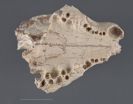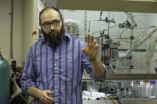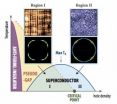(Press-News.org) A Case Western Reserve University student and his mentor have discovered an ancient kitten-sized predator that lived in Bolivia about 13 million years ago—one of the smallest species reported in the extinct order Sparassodonta.
Third-year undergraduate student Russell Engelman and Case Western Reserve anatomy professor Darin Croft made the finding by analyzing a partial skull that had been in a University of Florida collection more than three decades.
The researchers report their finding in the Journal of Vertebrate Paleontology online at: http://www.tandfonline.com/doi/full/10.1080/02724634.2013.827118#.U2p8-S8njhM.
"The animal would have been about the size of a marten, a catlike weasel found in the Northeastern United States and Canada, and probably filled the same ecological niche," said Engelman, an evolutionary biology major from Russell Township, Ohio.
The researchers refrained from naming the new species mainly because the specimen lacks well-preserved teeth, which are the only parts preserved in many of its close relatives.
The skull, which would have been a little less than 3 inches long if complete, shows the animal had a very short snout. A socket, or alveolus, in the upper jaw shows it had large, canines, that were round in cross-section much like those of a meat-eating marsupial, called the spotted-tailed quoll, found in Australia today, the researchers said.
Although sparassodonts are more closely related to modern opossums than cats and dogs, the group included saber-toothed species that fed on large prey. This small Bolivian species probably fed on the ancient relatives of today's guinea pigs and spiny rats, the researchers said.
"Most predators don't go after animals of equal size, but these features indicate this small predator was a formidable hunter," Croft said.
The specimen had not been studied in detail after being collected. It was provisionally identified as belonging to a particular group of extinct meat-eating opossums, due in part to its small size. Further adding to the identity challenge, almost all small sparassodonts have been identified by their teeth and lower jaws, which this skull lacks.
Croft wanted to study the skull because its age is nearly twice that of the oldest known species of meat-eating opossum. The specimen was found in a mountainous site known as Quebrada Honda, Bolivia, in 1978, in rock layers dated 12 million to 13 million years ago.
Structurally, extinct meat-eating opossums and sparassodont skulls share a number of similarities due to their similar meat-eating diet, Engelman said.
"No single feature found in the skull was so distinctive that we could say one way or the other what it was," Croft said, "but the combination of features is unique and says this is a sparassodont."
One key was that a particular bone of the orbit, the boney socket of the eye, does not touch the nasal bone in an opossum but does in a sparassodont.
The short snout was a kind of red herring. While jaguar-sized sparassodonts had them, the smaller members of the order had fox-like faces. And this species was smaller than most of those.
These smaller sparassodonts also have gaps between their teeth that are absent in most larger species. The skull shows no gaps.
Overall, the animal's features are a mixture of those found in different species of sparassodonts, but are not characteristic of in any one subgroup within the order. That puts this species near the bottom of the family tree, the researchers said.
Croft, who regularly collects from the same site where the skull was found, will return there this summer to gather evidence he hopes will show whether this species lived in an open grassland, forest or mixed habitat.
He also hopes to find the lower jaw, which may enable direct comparisons with known species and provide enough foundation to name the animal.
INFORMATION: END
Extinct kitten-sized hunter discovered
2014-05-08
ELSE PRESS RELEASES FROM THIS DATE:
Fueling aviation with hardwoods
2014-05-08
A key challenge in the biofuels landscape is to get more advanced biofuels—fuels other than corn ethanol and vegetable oil-based biodiesel—into the transportation pool. Utilization of advanced biofuels is stipulated by the Energy Independence and Security Act; however, current production levels lag behind proposed targets. Additionally, certain transportation sectors, such as aviation, are likely to continue to require liquid hydrocarbon fuels in the long term even as light duty transportation shifts to alternative power sources. A multi-university team lead by George ...
Chemotherapy timing is key to success
2014-05-08
CAMBRIDGE, Mass-- MIT researchers have devised a novel cancer treatment that destroys tumor cells by first disarming their defenses, then hitting them with a lethal dose of DNA damage.
In studies with mice, the research team showed that this one-two punch, which relies on a nanoparticle that carries two drugs and releases them at different times, dramatically shrinks lung and breast tumors. The MIT team, led by Michael Yaffe, the David H. Koch Professor in Science, and Paula Hammond, the David H. Koch Professor in Engineering, describe the findings in the May 8 online ...
Climate change may worsen summertime ozone pollution
2014-05-08
Ozone pollution across the continental United States will become far more difficult to keep in check as temperatures rise, according to new research results.
The study shows that Americans face the risk of a 70 percent increase in unhealthy summertime ozone levels by 2050.
The results appear online this week in a paper in the Journal of Geophysical Research-Atmospheres, published by the American Geophysical Union.
The work was funded by the National Science Foundation (NSF) and the U.S. Department of Energy.
Warmer temperatures and other changes in the atmosphere ...
Scientists find solution to 2 long-standing mysteries of cuprate superconductivity
2014-05-08
UPTON, NY—Scientists seeking to understand the intricacies of high-temperature superconductivity—the ability of certain materials to carry electrical current with no energy loss—have been particularly puzzled by a mysterious phase that emerges as charge carriers are added that appears to compete with superconductivity. It's also been a mystery why, within this "pseudogap" phase, the movement of superconducting electrons appears to be restricted to certain directions. So exploring the pseudogap and whether and how it affects the movement of electrons has been a pivotal challenge. ...
'Rice theory' explains north-south China cultural differences, study shows
2014-05-08
A new cultural psychology study has found that psychological differences between the people of northern and southern China mirror the differences between community-oriented East Asia and the more individualistic Western world – and the differences seem to have come about because southern China has grown rice for thousands of years, whereas the north has grown wheat.
"It's easy to think of China as a single culture, but we found that China has very distinct northern and southern psychological cultures and that southern China's history of rice farming can explain why people ...
Exploring the magnetism of a single atom
2014-05-08
Magnetic devices like hard drives, magnetic random access memories (MRAMs), molecular magnets, and quantum computers depend on the manipulation of magnetic properties. In an atom, magnetism arises from the spin and orbital momentum of its electrons. 'Magnetic anisotropy' describes how an atom's magnetic properties depend on the orientation of the electrons' orbits relative to the structure of a material. It also provides directionality and stability to magnetization. Publishing in Science, researchers led by EPFL combine various experimental and computational methods to ...
Plant hormone has dual role in triggering flower formation, Penn study finds
2014-05-08
Flowers aren't just pretty to look at, they are how plants reproduce. In agricultural plants, the timing and regulation of flower formation has economic significance, affecting a crop's yield.
A new paper by researchers at the University of Pennsylvania published in the journal Science has revealed that a plant hormone once believed to promote flower formation in annual plants also plays a role in inhibiting flowers from forming. The dual role of this hormone, gibberellin, could be exploited to produce higher-yielding crop plants.
The study was led by Nobutoshi Yamaguchi ...
GaitTrack app makes cellphone a medical monitor for heart and lung patients
2014-05-08
CHAMPAIGN, Ill. — By simply carrying around their cellphones, patients who suffer from chronic disease could soon have an accurate health monitor that warns their doctors when their symptoms worsen.
GaitTrack, an app developed by researchers at the University of Illinois at Urbana-Champaign and the U. of I. at Chicago, turns a smartphone into a sophisticated medical device. Unlike other apps that merely count steps, GaitTrack uses eight motion parameters to perform a detailed analysis of a person's gait, or walking pattern, which can tell physicians much about a patient's ...
Tackling test anxiety may help prevent more severe problems
2014-05-08
Showing students how to cope with test anxiety might also help them to handle their built-up angst and fretfulness about other issues. The results of a new study by Carl Weems of the University of New Orleans show that anxiety intervention programs that focus on academic matters fit well into the demands of the school routine, and do not carry the same stigma among youth as general anxiety programs do. The research group was among the first to study the effects of Hurricane Katrina on community mental health and anxiety among youths, and the paper appears in Prevention ...
Ovarian cancer cells are more aggressive on soft tissues
2014-05-08
When ovarian cancer spreads from the ovaries it almost always does so to a layer of fatty tissue that lines the gut. A new study has found that ovarian cancer cells are more aggressive on these soft tissues due to the mechanical properties of this environment. The finding is contrary to what is seen with other malignant cancer cells that seem to prefer stiffer tissues.
"What we found is that there are some cancer cells that respond to softness as opposed to stiffness," said Michelle Dawson, an assistant professor in the School of Chemical and Biomolecular Engineering ...






